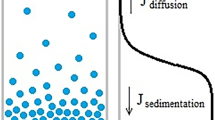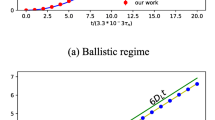Abstract
In this study, the Taylor-series expansion method of moments is developed to describe the dynamic behaviour of nanoparticles considering both the effects of coagulation and deposition in closed environments, where the two effects have always been studied separately before. Compared with traditional methods of moments, the new method could give more accurate results for solving the general dynamics equation. In addition, moment equations with respect to coagulation and deposition considering the fractal dimension (Df) of particles are acquired, and the results are compared with experimental data and are more accurate than the simulation results under the assumption of spherical mode. The new dynamic model could be applied in more real conditions with different microstructures of nanoparticles. With decreasing Df, the particle number concentration decreases more rapidly, additionally, Df has a relatively greater effect on the agglomeration of smaller particles under the same initial concentration. Moreover, the effect of the initial number concentration on coagulation is also studied. The results show that a higher initial number concentration or a smaller particle size could have a greater effect of coagulation on the evolution of particles.
Similar content being viewed by others
References
Hand J. L., Schichtel B. A., Malm W. C. et al. Widespread reductions in haze across the United States from the early 1990s through 2011 [J]. Atmospheric Environment, 2014, 94: 671–679.
Deng H., Eckel S. P., Liu L. et al. Particulate matter air pollution and liver cancer survival [J]. International Journal of Cancer, 2017, 141(4): 744–749.
Rigopoulos S. Population balance modelling of polydispersed particles in reactive flows [J]. Progress in Energy & Combustion Science, 2010, 36(4): 412–443.
Hussein T., Dohanyosova H. P., Dzumbova L. et al. Deposition rates on smooth surfaces and coagulation of aerosol particles inside a test chamber [J]. Atmospheric Environment, 2009, 43(4): 905–914.
Rim D., Green M., Wallace L. et al. Evolution of ultrafine particle size distributions following indoor episodic releases: Relative importance of coagulation, deposition and ventilation [J]. Aerosol Science and Technology, 2012, 46(5): 494–503.
Yu M., Lin J., and Chan T. A new moment method for solving the coagulation equation for particles in brownian motion [J]. Aerosol Science and Technology, 2008, 42(9): 705–713.
Yu M. and Lin J. Binary homogeneous nucleation and growth of water-sulfuric acid nanoparticles using a TEMOM model [J]. International Journal of Heat & Mass Transfer, 2010, 53(4): 635–644.
Xie M. L. Asymptotic behavior of TEMOM model for particle population balance equation over the entire particle size regimes [J]. Journal of Aerosol Science, 2014, 67(1): 157–165.
Sun Z. Dynamic characteristic of the size spectrum of submicron particles from cigarette combustion [J]. Journal of Engineering Thermophysics, 2008, 29(2): 343–346.
Friedlander S. K. and Marlow W. H. Smoke, Dust and Haze: Fundamentals of Aerosol Behavior [J]. Physics Today, 1977, 30(9): 58–59.
Pratsinis S. E. Simultaneous nucleation, condensation, and coagulation in aerosol reactors [J]. Journal of Colloid & Interface Science, 1988, 124(2): 416–427.
Xie M., Li J., Kong T., and He Q. An improved particle population balance equation in the continuum-slip regime [J]. Thermal Science, 2016, 20(3): 921–926.
Otto E., Fissan H., Park S. H. et al. The log-normal size distribution theory of brownian aerosol coagulation for the entire particle size range: part II—analytical solution using Dahneke’s coagulation kernel [J]. Journal of Aerosol Science, 1999, 30(1): 17–34.
Ghosh D. and Kumar J. Existence of mass conserving solution for the coagulation-fragmentation equation with singular kernel [J]. Japan Journal of Industrial and Applied Mathematics, 2018, 35(3): 1283–1302.
Guichard R., Tanière A., Belut E., and Rimbert N. Simulation of nanoparticle coagulation under Brownian motion and turbulence in a differential-algebraic framework: Developments and applications [J]. International Journal of Multiphase Flow, 2014, 64(3): 73–84.
Vanni M. Approximate population balance equations for aggregation-breakage processes [J]. Journal of Colloid & Interface Science, 2000, 221(2): 143–160.
Yu M. and Lin J. Taylor-expansion moment method for agglomerate coagulation due to Brownian motion in the entire size regime [J]. Journal of Aerosol Science, 2009, 40(6): 549–562.
Xu G. P. and Wang J. S. CFD modeling of particle dispersion and deposition coupled with particle dynamical models in a ventilated room [J]. Atmospheric Environment, 2017, 166: 300–314.
Kim D. S., Hong S. B., Kim Y. J. et al. Deposition and coagulation of polydisperse nanoparticles by Brownian motion and turbulence [J]. Journal of Aerosol Science, 2006, 37(12): 1781–1787.
Vemury S. and Pratsinis S. E. Self-preserving size distributions of agglomerates [J]. Journal of Aerosol Science, 1995, 26(2): 175–185.
Zhao L., Chen C., Wang P. et al. Characteristics of change of PM_(2.5) mass concentration indoors and outdoors in an office building in Beijing in summer and winter [J]. Building Science, 2015.
Yu M., Koivisto A. J., Hämeri K., and Seipenbusch M. Size Dependence of the Ratio of Aerosol Coagulation to Deposition Rates for Indoor Aerosols [J]. Aerosol Science & Technology, 2013, 47(4): 427–434.
Anand S., Mayya Y. S., Yu M. et al. A numerical study of coagulation of nanoparticle aerosols injected continuously into a large, well stirred chamber [J]. Journal of Aerosol Science, 2012, 52(1): 18–32.
Ma S. H., Zhang Y. M., Fang J. et al. Fire Smoke Particle Size Distribution Evolution Under Brownian Coagulation [J]. Journal of Combustion Science & Technology, 2007, 13(2): 147–151.
Author information
Authors and Affiliations
Corresponding author
Additional information
Biography: Guang-ping Xu (1987-), Male, Ph. D.
Rights and permissions
About this article
Cite this article
Xu, Gp., Wang, Js. Development and application of moment method on nanoparticles evolution due to coagulation and deposition. J Hydrodyn 31, 1011–1020 (2019). https://doi.org/10.1007/s42241-019-0059-4
Received:
Revised:
Accepted:
Published:
Issue Date:
DOI: https://doi.org/10.1007/s42241-019-0059-4




